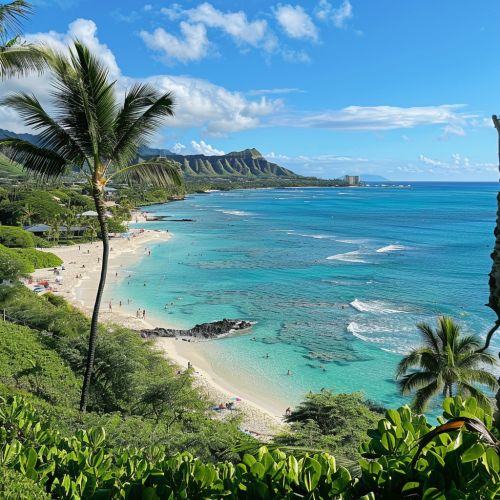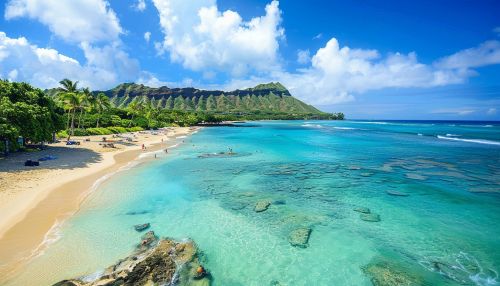Oahu: Difference between revisions
(Created page with "== Geography and Topography == Oahu, the third largest of the Hawaiian Islands, is a significant landmass located in the central Pacific Ocean. It is part of the state of Hawaii, United States. The island covers an area of approximately 597 square miles (1,545 square kilometers) and is characterized by its diverse topography, which includes mountain ranges, valleys, and coastal plains. <div class='only_on_desktop image-preview'><div class='image-preview-loader'></div><...") |
No edit summary |
||
| Line 3: | Line 3: | ||
Oahu, the third largest of the Hawaiian Islands, is a significant landmass located in the central Pacific Ocean. It is part of the state of Hawaii, United States. The island covers an area of approximately 597 square miles (1,545 square kilometers) and is characterized by its diverse topography, which includes mountain ranges, valleys, and coastal plains. | Oahu, the third largest of the Hawaiian Islands, is a significant landmass located in the central Pacific Ocean. It is part of the state of Hawaii, United States. The island covers an area of approximately 597 square miles (1,545 square kilometers) and is characterized by its diverse topography, which includes mountain ranges, valleys, and coastal plains. | ||
[[Image:Detail-91237.jpg|thumb|center|A scenic beach on Oahu with clear blue waters and palm trees.|class=only_on_mobile]] | |||
[[Image:Detail-91238.jpg|thumb|center|A scenic beach on Oahu with clear blue waters and palm trees.|class=only_on_desktop]] | |||
The island is geologically formed by two separate shield volcanoes: the Waiʻanae and Koʻolau Ranges. These volcanic mountains are connected by a central plateau. The highest point on Oahu is Mount Kaʻala in the Waiʻanae Range, which rises to an elevation of 4,003 feet (1,220 meters). The Koʻolau Range, although not as high, is equally significant, with its highest peak, Konahuanui, reaching 3,150 feet (960 meters). | The island is geologically formed by two separate shield volcanoes: the Waiʻanae and Koʻolau Ranges. These volcanic mountains are connected by a central plateau. The highest point on Oahu is Mount Kaʻala in the Waiʻanae Range, which rises to an elevation of 4,003 feet (1,220 meters). The Koʻolau Range, although not as high, is equally significant, with its highest peak, Konahuanui, reaching 3,150 feet (960 meters). | ||
Latest revision as of 05:01, 22 June 2024
Geography and Topography
Oahu, the third largest of the Hawaiian Islands, is a significant landmass located in the central Pacific Ocean. It is part of the state of Hawaii, United States. The island covers an area of approximately 597 square miles (1,545 square kilometers) and is characterized by its diverse topography, which includes mountain ranges, valleys, and coastal plains.


The island is geologically formed by two separate shield volcanoes: the Waiʻanae and Koʻolau Ranges. These volcanic mountains are connected by a central plateau. The highest point on Oahu is Mount Kaʻala in the Waiʻanae Range, which rises to an elevation of 4,003 feet (1,220 meters). The Koʻolau Range, although not as high, is equally significant, with its highest peak, Konahuanui, reaching 3,150 feet (960 meters).
Oahu's coastline is diverse, featuring numerous bays, inlets, and beaches. Notable coastal features include Waikiki Beach, Hanauma Bay, and the North Shore, famous for its surf breaks. The island's terrain also includes fertile valleys such as the Manoa and Nuuanu Valleys, which are important for agriculture and residential development.
Climate
Oahu experiences a tropical climate with two distinct seasons: the dry season (kau) from May to October and the wet season (hooilo) from November to April. The island's climate is moderated by the trade winds, which blow from the northeast, providing a cooling effect and contributing to the island's overall mild weather.
The average annual temperature on Oahu ranges from 70°F (21°C) to 85°F (29°C), with little variation throughout the year. Rainfall varies significantly across the island, with the windward (northeastern) side receiving more precipitation due to orographic lift, while the leeward (southwestern) side remains relatively dry. The wettest months are typically December and January, while the driest months are June and July.
Demographics
Oahu is the most populous island in Hawaii, home to approximately one million residents, which accounts for about 70% of the state's total population. The island's population is highly diverse, with a mix of ethnicities including Native Hawaiians, Asians, Caucasians, and Pacific Islanders.
The largest city on Oahu is Honolulu, which is also the state capital and the principal port. Honolulu's metropolitan area encompasses the entire island, making it the economic and cultural hub of Hawaii. Other significant urban areas include Kailua, Kaneohe, and Pearl City.
History
Oahu has a rich history that dates back to ancient Polynesian settlers who arrived on the island around 1,500 years ago. These early inhabitants established complex societies with distinct social hierarchies and developed advanced agricultural and aquacultural systems.
The island played a crucial role in Hawaiian history, particularly during the unification of the Hawaiian Islands under King Kamehameha I in the late 18th century. Oahu was the site of several key battles, including the Battle of Nuʻuanu in 1795, which solidified Kamehameha's control over the island.
In the 19th century, Oahu became a center of trade and commerce, attracting missionaries, whalers, and merchants from around the world. The establishment of the Kingdom of Hawaii's government in Honolulu further cemented the island's importance.
Economy
Oahu's economy is diverse, with major sectors including tourism, military, agriculture, and technology. Tourism is the largest industry, with millions of visitors flocking to the island each year to enjoy its natural beauty, cultural attractions, and recreational activities. Key tourist destinations include Waikiki, Pearl Harbor, and the Polynesian Cultural Center.
The military presence on Oahu is significant, with several major installations including Joint Base Pearl Harbor-Hickam, Schofield Barracks, and Marine Corps Base Hawaii. These facilities contribute to the local economy through employment and federal spending.
Agriculture remains an important sector, with crops such as pineapples, sugarcane, and coffee being historically significant. In recent years, diversified agriculture, including the cultivation of tropical fruits, vegetables, and flowers, has gained prominence.
The technology sector is also growing, with a focus on research and development in areas such as renewable energy, oceanography, and biotechnology. The University of Hawaii at Manoa and other research institutions play a key role in driving innovation and economic growth.
Culture
Oahu is a cultural melting pot, with a rich tapestry of traditions and customs influenced by its diverse population. The island is known for its vibrant arts scene, including traditional Hawaiian music and dance, contemporary art, and theater. The annual Merrie Monarch Festival, held in Hilo, celebrates Hawaiian culture through hula competitions and cultural exhibitions.
The island's culinary scene reflects its multicultural heritage, with a wide range of cuisines available, from traditional Hawaiian dishes to Japanese, Chinese, Filipino, and American fare. Popular local foods include poke, laulau, and malasadas.
Oahu is also home to numerous cultural and historical sites, including the Bishop Museum, Iolani Palace, and the USS Arizona Memorial. These sites offer insights into the island's history and heritage, attracting both residents and visitors.
Education
Oahu boasts a comprehensive education system, with numerous public and private schools, as well as higher education institutions. The Hawaii Department of Education oversees the public school system, which includes elementary, middle, and high schools across the island.
The University of Hawaii at Manoa is the flagship campus of the University of Hawaii system, offering a wide range of undergraduate and graduate programs. Other notable higher education institutions on Oahu include Hawaii Pacific University, Chaminade University, and Honolulu Community College.
Transportation
Oahu has a well-developed transportation infrastructure, including roads, highways, public transit, and an international airport. The island's road network includes several major highways, such as the H-1, H-2, and H-3 freeways, which connect different parts of the island.
Public transportation is provided by TheBus, a comprehensive bus system that serves the entire island. TheBus is known for its extensive coverage and affordability, making it a popular choice for both residents and visitors.
Daniel K. Inouye International Airport, located in Honolulu, is the primary gateway to Oahu and the state of Hawaii. The airport handles both domestic and international flights, connecting the island to major cities around the world.
Environmental Concerns
Oahu faces several environmental challenges, including coastal erosion, invasive species, and the impacts of climate change. Coastal erosion is a significant issue, particularly along the island's beaches, where rising sea levels and increased storm activity contribute to shoreline retreat.
Invasive species, such as the coqui frog and the little fire ant, pose threats to Oahu's native ecosystems and biodiversity. Efforts to control and eradicate these species are ongoing, involving government agencies, research institutions, and community organizations.
Climate change impacts, including rising temperatures, altered precipitation patterns, and increased frequency of extreme weather events, pose long-term risks to Oahu's environment and economy. Adaptation and mitigation strategies are being developed to address these challenges, with a focus on sustainability and resilience.
